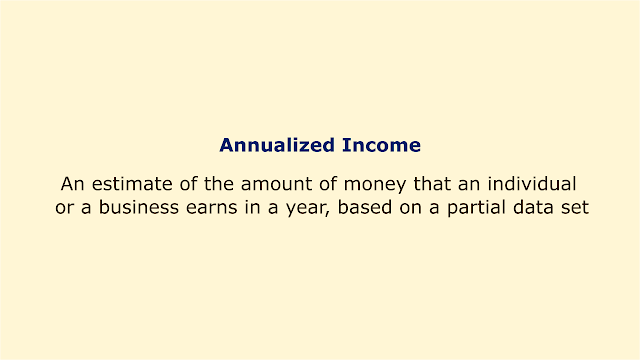 |
| Image: Moneybestpal.com |
Annualized income is an estimate of the amount of money that an individual or a business earns in a year, based on a partial data set. Budgeting, tax preparation, and income comparison across several time periods or sources can all benefit from it.
The assumption that the pattern of revenue would be constant over the course of the year, which may not be the case for all sources of income, makes annualized income less reliable than actual income in some cases.
Nevertheless, if the freelancer's revenue varies dramatically from month to month or season to season, this method might not accurately represent their total annual income. The annualized income based on the first quarter, for instance, may overestimate the yearly income if the freelancer makes more money in the winter than in the summer. However, the annualized revenue based on the first quarter may underestimate the yearly income if the freelancer earns more in the later months of the year than in the earlier months.
Taxpayers can utilize the annualized income installment method (AIIM), which enables them to compute their expected tax payments based on their actual income for each quarter, to prevent underpaying or overpaying taxes as a result of variable income. Using various annualization factors for each quarter when completing Schedule AI of Form 2210 is required for this procedure. For instance, the annualization factor is four for the first quarter, 2.4 for the second, 1.5 for the third, and one for the fourth.
The annualized income for the first quarter, using the same example as above, would be $45,000 x 4 = $180,000 if the freelancer made $15,000 in January, $18,000 in February, and $12,000 in March. Yet, if the independent contractor made $10,000 in April, $8,000 in May, and $9,000 in June, the second quarter's annualized income would be ($45,000 + $27,000) x 2.4, or $172,800. The freelancer can then modify their predicted tax payments to reflect their real income for each quarter.
To determine annualized income, multiply the earned income amount by the ratio of 12 months divided by the number of months for which income data is available. A freelancer might have made $45,000 in total during the first quarter if, for instance, they made $15,000 in January, $18,000 in February, and $12,000 in March. One can multiply $45,000 by 12/3 to get $180,000 if they want to annualize this income.
Nevertheless, if the freelancer's revenue varies dramatically from month to month or season to season, this method might not accurately represent their total annual income. The annualized income based on the first quarter, for instance, may overestimate the yearly income if the freelancer makes more money in the winter than in the summer. However, the annualized revenue based on the first quarter may underestimate the yearly income if the freelancer earns more in the later months of the year than in the earlier months.
Taxpayers can utilize the annualized income installment method (AIIM), which enables them to compute their expected tax payments based on their actual income for each quarter, to prevent underpaying or overpaying taxes as a result of variable income. Using various annualization factors for each quarter when completing Schedule AI of Form 2210 is required for this procedure. For instance, the annualization factor is four for the first quarter, 2.4 for the second, 1.5 for the third, and one for the fourth.
The annualized income for the first quarter, using the same example as above, would be $45,000 x 4 = $180,000 if the freelancer made $15,000 in January, $18,000 in February, and $12,000 in March. Yet, if the independent contractor made $10,000 in April, $8,000 in May, and $9,000 in June, the second quarter's annualized income would be ($45,000 + $27,000) x 2.4, or $172,800. The freelancer can then modify their predicted tax payments to reflect their real income for each quarter.
